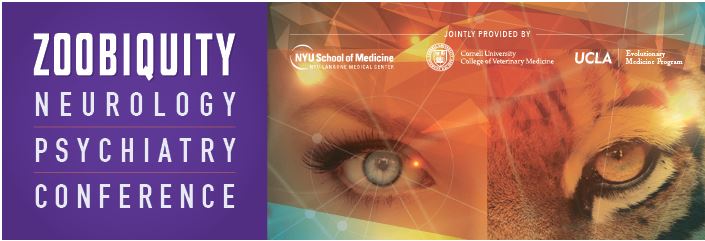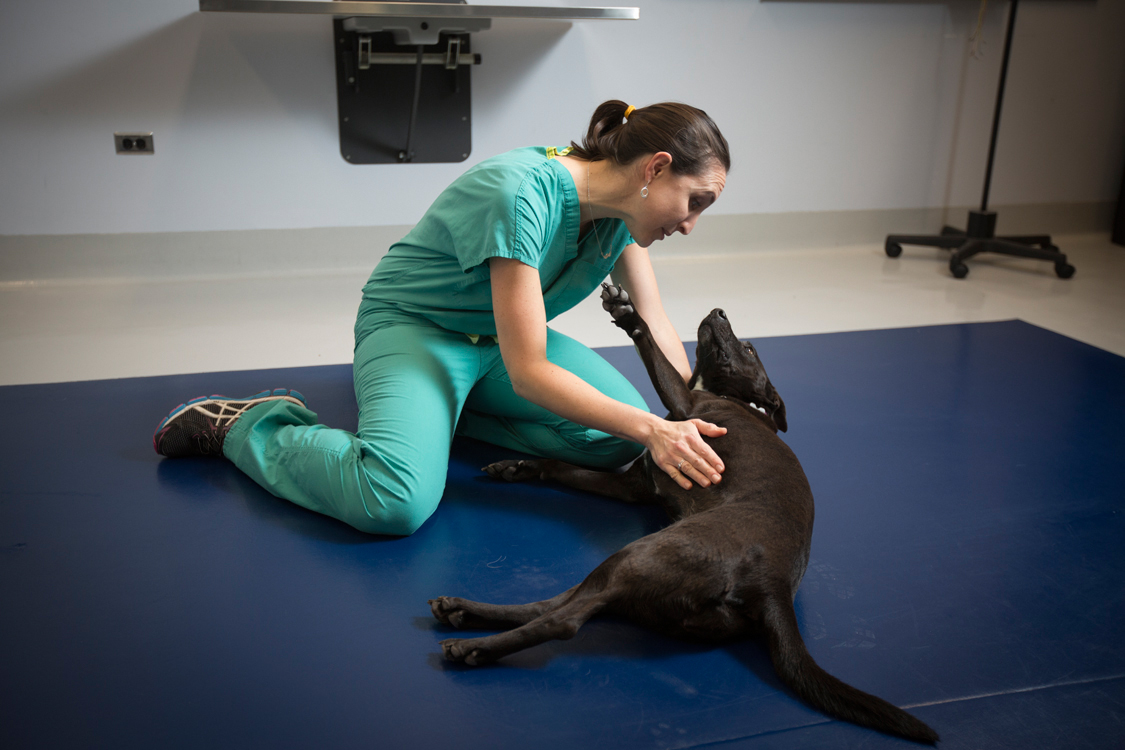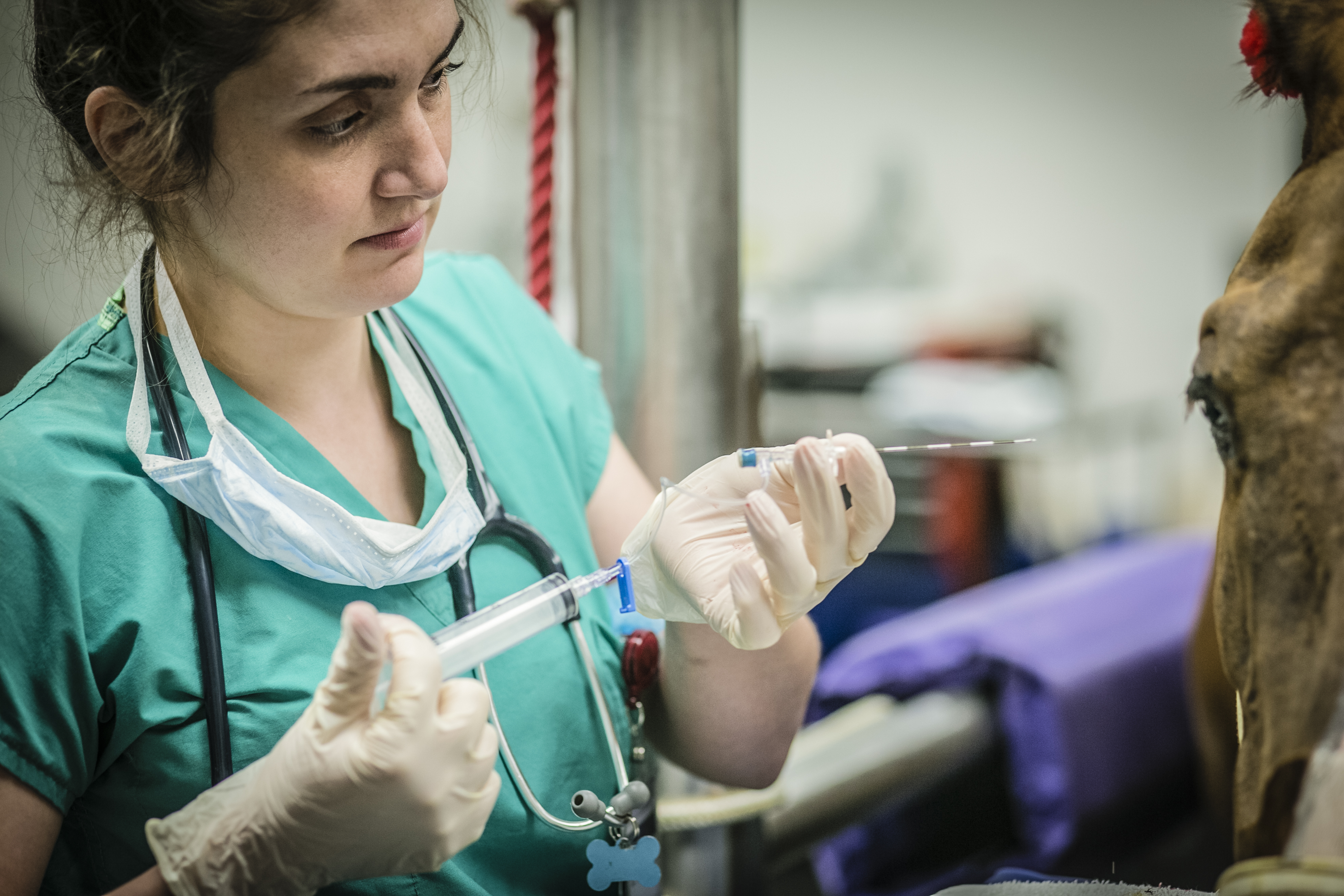College faculty educate and engage at Zoobiquity conference
Compulsively licking cats; head-bobbing Bulldogs and a Wirehaired Griffon with a phantom-limb. These are just a sampling of the cases discussed by College faculty at the Zoobiquity Neurology and Psychiatry Conference—a one-of-a-kind meeting of animal and human researchers and clinicians co-sponsored by the Cornell University College of Veterinary Medicine along with New York University Langone Medical Center and the Evolutionary Medicine Program at UCLA. Cornell planning committee members Dr. Alexander Travis, associate dean of international programs and public health, and Gen Meredith, associate director for international programs and MPH, recruited top-level College faculty members to present at the meeting. “Our faculty just have an outstanding reputation in any arena,” says Meredith. “This conference was no different—their presentations were engaging and informative, and really demonstrated the excellence of the work we do at the College.”
Starting the conversation
Conference-series Founder Dr. Barbara Natterson-Horowitz, a human cardiologist and co-director of the evolutionary medicine program at UCLA, began the event by noting the crucial need for collaboration between veterinary and medical researchers. “Despite so many seeming commonalities across species, there has been so little conversation between vets and doctors,” she said.
The Zoobiquity conference enabled this conversation; each conference agenda item centered on a neurological or psychiatric issue, featuring both a human and animal researcher’s talk on the topic. Presentations included “Anxiety and Compulsions in Human, Feline & Canine Patients,” and “Movement Disorders in People and Pets,” giving attendees both a veterinary and medical perspective.
College student Amari Suskin-Sperry ’19, who attended the conference along with nine other Cornell DVM students, found the format enlightening. “As we’re training in this profession, we often forget about the human aspect of a condition or disease,” she said. “It’s very informative to see the human side of certain conditions, and I hope there will be more dialogue between our professions in the future.”
Anxious animals, aging canines
Animal behavior expert Dr. Pamela Perry, lecturer in small animal behavior at the College, discussed the common anxiety and compulsive disorders in companion animals, such as cats that won’t stop licking, or dogs with separation anxiety. She discussed potential treatments for these issues, including reducing exposure to anxiety-provoking stimuli. “If I could give you all one tip, it would be to never use a laser pointer with your dog,” Perry said. “They can never get that dot, and seems to drive some of them nuts.”
Dr. Katherine Houpt, James Law Professor of Behavior Medicine, emeritus, described cases of elderly canine patients with cognitive dysfunction. “By age sixteen, all dogs apparently have cognitive dysfunction,” said Houpt, noting that many owners get frustrated with elderly dogs’ behavioral issues that develop as a result. “I’m sure cats have it too, but cats tend to get nicer with age, so you don’t see as many feline cases [of cognitive dysfunction].” To the surprise of many, she noted that feeding elderly dogs a specially-formulated diet was more effective than medication.
Movement problems, persistent pain

Dr. Sophia Cerda-Gonzalez, section chief of neurology at Cornell, presented on movement disorders in dogs, explaining that they’re primarily categorized by breed: “Scotty cramps;” “episodic falling syndrome” in young Cavalier King Charles spaniels; or head bobbing in young Dobermans, Boxers, and Bulldogs. She showed a number of video clips along with her movement disorders examples, which conference presenter Dr. Jesse Goldberg, assistant professor in the department of neurobiology at Cornell, found fascinating. “As an MD focused on neurobiology, it was really interesting to see Dr. Cerda-Gonzalez’s video of dogs with myoclonus,” Goldberg said. “It’s almost identical to what’s observed in humans, and to see that similarity across species is striking.”
College anesthesiologist Dr. Jordyn Boesch also highlighted the similarities between humans and animals in her presentation on pain in animals. “We may never know exactly what animals are going through when they’re experiencing pain,” said Boesch, “however their neuroanatomy and neurophysiology are nearly similar to ours, and it’s safe to assume their experience of pain is very similar to the human experience.” Despite that, Boesch explained that the state of pain assessment and relief for animal patients is behind that of humans—for example, no neuropathic pain scale exists for cats and dogs, and that cattle are not given analgesia after castration. Additionally, “We never thought animals develop phantom limb pain, something that we know is agonizing in humans” said Boesch, “but I’ve encountered four patients that I’m absolutely certain were suffering from that condition.”

Cornell's Large Animal Hospital
An inclusive future
After every presentation, questions from the audience flooded in—sparking lively discussions on the presented topics and beyond. Clearly, the Zoobiquity conference accomplished Natterson-Horowitz’s goal of sparking dialogue across specialties and species, and holds promise for a more collaborative future. Cornell DVM student Ari Boltax ’18 said she appreciated the chance to see both human and animal experts speak about neurobiology and psychology, noting how the two worlds can benefit each other. “Our experience treating multiple species certainly gives vets a unique approach to problem-solving that has a lot of benefits for human health. On the flip side, because of the breadth of our service, the depth of our research for each species trails that of humans, and vets have a lot to learn from innovative research in humans that can apply to our non-human animal species." For Boltax, the conference represented an instrumental synergy for her future career. “I was instantly drawn to this conference,” she said. “I have always had a fascination with the commonalities between human and animal medicine—modern veterinary medicine would not exist without the human-animal bond, so my degree is necessarily inclusive.”




